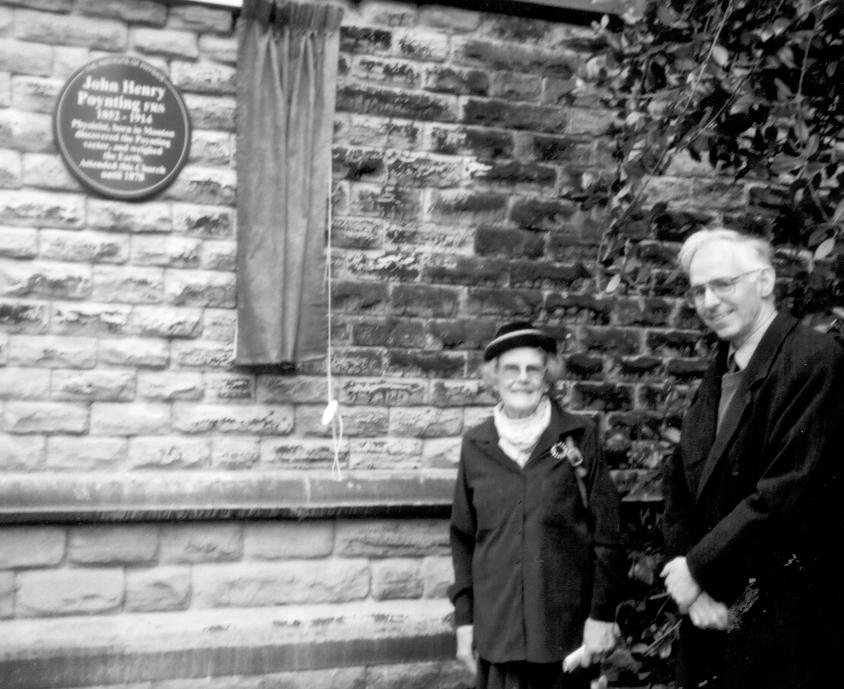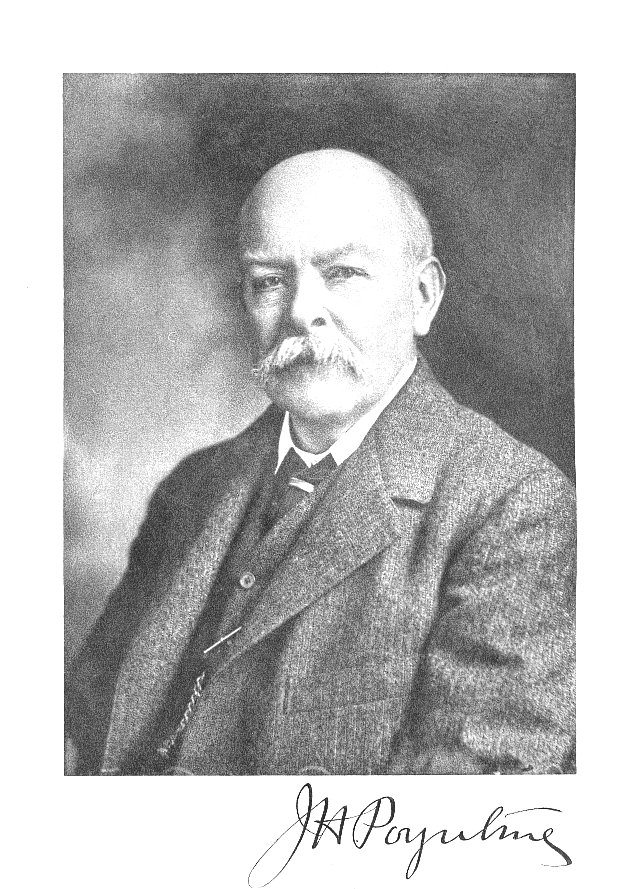
Mrs Elizabeth Ratcliffe and Dr. Richard Potton.
There is now an Institute of Physics plaque to John Henry Poynting at Monton Unitarian Church in Greater Manchester. The Church dates back to 1875 and was erected by the physicist's father, the Reverend Thomas Elford Poynting. The unveiling took place on Saturday, 17th March 2001. Following an informal tour of the Church and grounds, Dr Richard Potton, Chairman of the Manchester Branch, introduced Dr Peter Rowlands, who gave a brief account of Poynting's career and scientific achievement. Then, Mrs Elizabeth Ratcliffe, grand-daughter of the physicist, formally unveiled the plaque, while Mr Julian Poynting, his great-nephew, gave a vote of thanks, and the Reverend Brenda Catherall, Minister of Monton Unitarian Church gave a Prayer of Dedication. Approximately sixty people attended, including many members of the Poynting family.

Location
Take M602 to junction 2, A576 towards Eccles. After a few hundred yards you
are signposted left to Monton, ending up at Monton Green where the church is
clearly visible.

John Henry Poynting was born in the parsonage at Monton, Lancashire, on 9th September 1852, the youngest son of an equally remarkable father. Thomas Elford Poynting was a self-educated teacher from the West Country who took up a position at Flowery Fields in Manchester in 1841. He obviously didn't think that the name implied Earthly Paradise for, we are told in The Inquirer (1878), "He used in later life to describe the dread with which he contemplated settling among the fierce and half civilised people of the North of whose uncouth manners and violent deeds he had heard." However, he accepted the post of Minister at the Unitarian chapel in Monton in 1846 and remained there for 32 years; during his time there (1875) he built the magnificent church at Monton Green, which has now been superbly restored with the help of English Heritage. T. E. Poynting had a great interest in science, especially physics, and wrote educational works on science. The son's early education was at his father's school near the church. From there he went to Owens College, Manchester (1867-1872), gaining a BSc from the University of London in 1876, and Trinity College, Cambridge (1872-1876), where he graduated as third wrangler.
He then returned to Manchester as a demonstrator in the Physics Department (1876-78), during which period he lived with his father and attended the new church. While at Manchester, he began a lifelong friendship with J. J. Thomson, with whom he subsequently completed a large A Text-book of Physics in 4 volumes. At Manchester, he also produced two statistical studies on drunkenness (in which Manchester and Salford come out very badly, perhaps confirming his father's apprehensions after all!), and began a project to measure Newton's universal gravitational constant G (or, equivalently, the density of the Earth). In 1878 he became a fellow of Trinity College, Cambridge, working in the Cavendish Laboratory under James Clerk Maxwell. (He was awarded a Cambridge ScD in 1887.) His father died during that year and we have a record of the son attending the funeral at Monton. (Thomas Elford Poynting's is one of fifteen family graves in the churchyard.) His final career move was to become first Professor of Physics at Mason College, Birmingham (subsequently, the University), in 1880. In the same year, he married Maria Adney Cropper, daughter of a Unitarian minister at Stand, near Manchester, by whom he had three children.
Poynting remained at Birmingham until his death, at Edgbaston, on 30th March 1914. It was there that he found an atmosphere conducive to doing all his most important scientific work. Elected FRS in 1888, he was awarded the Adams Prize from Cambridge, University, in 1892, for an essay on "The Mean Density of the Earth", and the Hopkins Prize of Cambridge Physical Society in 1903. He received the Royal Medal of the Royal Society in 1905, and was Bakerian Lecturer in 1910. He served as President of the Physical Society in 1905 and as Vice-President of the Royal Society from 1910 to 1911.
Poynting was equally outstanding as a theoretical scientist and an
experimentalist. His greatest discovery was the Poynting theorem (1883), an
equation representing the energy balance in a closed region of an
electromagnetic field, from which comes an expression for the flow of energy
(the Poynting flux), represented by the Poynting vector:
In the same year Poynting produced a remarkable paper, in the Mason College Magazine, partly based on an earlier discussion by Felix Eberty, in which, 22 years before Einstein's theory of relativity, he discussed how time, measured by light signals, would seem to be extended to a space traveller approaching, say, somewhere like Sirius, at close to the speed of light, the speed of light, and how time would be effectively reversed if one exceeded it, with the second law of thermodynamics being violated, so that stones would suddenly find 'the ground beneath them grow too hot to hold them', and so be 'thrust up into the air to fall into schoolboys' hands', while 'rivers would run up-hill'. He says: 'It would require a Jules Verne to describe life as it would be in such a system.' Poynting had, however, shown that he had a vivid scientific imagination of his own.
As an experimenter, Poynting managed to measure the gravitational constant (G), using a relatively ordinary type of beam balance to obtain a value which agrees with the modern value to 4 parts in a thousand (1891). He showed, in 1905, that gravitational attractions between crystals were not dependent on orientation or temperature. In optical work, carried out with his colleague, Guy Barlow, he found that the reflection of light from a partially absorbing surface caused a tangential stress along the surface, and that refraction of a beam of light through a prism caused a torque on the prism (1905); while the emission of heat radiation by a body caused it to recoil in the same way as a gun firing a bullet (1909). The delicate apparatus which Poynting used to discover these entirely new effects, together with the beam balance he used for his gravitational work, is still preserved and displayed in the Poynting Laboratory at Birmingham, now named after him.
Poynting made contributions in many other fields, including a theory of change of state (1881) and another on osmotic pressure (1891), but one area of particular interest was astronomy. He was a keen observer and his telescope still survives. He discovered the retarding effect produced by the transfer of momentum between photons and particles in motion about the Sun, now called the Poynting-Roberston effect, which results in small particles of dust being driven by radiation into the body of the Sun (1903), and calculated that the temperature of Mars would be too low to support life as we now know it. A lunar crater has been named the Poynting crater in his honour. He also had a great interest in the philosophy of physics, partly stemming from his Unitarian background and his father's educational influence. In 1893, he argued against the finality of mechanistic models in physics, and, six years later, gave an extensive account of his views on the philosophy of physics in a Presidential Address to Section A of the BA. According to his friend Thomson, he was a "very successful" teacher, and he was, from all accounts, very well liked by his colleagues. All known portraits of Poynting show him wearing a ring instead of a knot in his tie. After his death, his colleague Guy Barlow wore Poynting's ring in his own tie for the rest of his life.
Published in the History of Physics Group newsletter No 15 2002 p 33 - 38